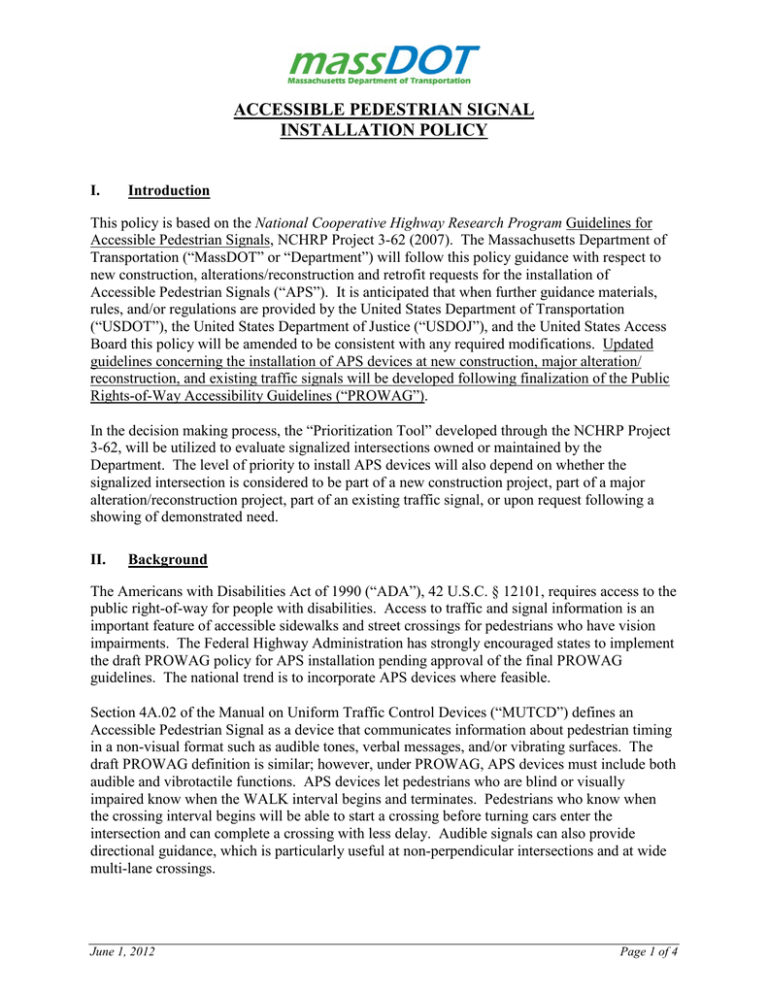ACCESSIBLE PEDESTRIAN SIGNAL INSTALLATION POLICY
advertisement

ACCESSIBLE PEDESTRIAN SIGNAL INSTALLATION POLICY I. Introduction This policy is based on the National Cooperative Highway Research Program Guidelines for Accessible Pedestrian Signals, NCHRP Project 3-62 (2007). The Massachusetts Department of Transportation (“MassDOT” or “Department”) will follow this policy guidance with respect to new construction, alterations/reconstruction and retrofit requests for the installation of Accessible Pedestrian Signals (“APS”). It is anticipated that when further guidance materials, rules, and/or regulations are provided by the United States Department of Transportation (“USDOT”), the United States Department of Justice (“USDOJ”), and the United States Access Board this policy will be amended to be consistent with any required modifications. Updated guidelines concerning the installation of APS devices at new construction, major alteration/ reconstruction, and existing traffic signals will be developed following finalization of the Public Rights-of-Way Accessibility Guidelines (“PROWAG”). In the decision making process, the “Prioritization Tool” developed through the NCHRP Project 3-62, will be utilized to evaluate signalized intersections owned or maintained by the Department. The level of priority to install APS devices will also depend on whether the signalized intersection is considered to be part of a new construction project, part of a major alteration/reconstruction project, part of an existing traffic signal, or upon request following a showing of demonstrated need. II. Background The Americans with Disabilities Act of 1990 (“ADA”), 42 U.S.C. § 12101, requires access to the public right-of-way for people with disabilities. Access to traffic and signal information is an important feature of accessible sidewalks and street crossings for pedestrians who have vision impairments. The Federal Highway Administration has strongly encouraged states to implement the draft PROWAG policy for APS installation pending approval of the final PROWAG guidelines. The national trend is to incorporate APS devices where feasible. Section 4A.02 of the Manual on Uniform Traffic Control Devices (“MUTCD”) defines an Accessible Pedestrian Signal as a device that communicates information about pedestrian timing in a non-visual format such as audible tones, verbal messages, and/or vibrating surfaces. The draft PROWAG definition is similar; however, under PROWAG, APS devices must include both audible and vibrotactile functions. APS devices let pedestrians who are blind or visually impaired know when the WALK interval begins and terminates. Pedestrians who know when the crossing interval begins will be able to start a crossing before turning cars enter the intersection and can complete a crossing with less delay. Audible signals can also provide directional guidance, which is particularly useful at non-perpendicular intersections and at wide multi-lane crossings. June 1, 2012 Page 1 of 4 MassDOT Accessible Pedestrian Signal Installation Policy III. Design and Installation for New Construction and Major Alterations/Reconstruction The major Alteration/Reconstruction of intersections is considered to constitute a substantial modification of an existing traffic signal at an intersection. A major alteration or reconstruction involves physical relocation or replacement of traffic signal infrastructure (as an example, addition of turn lanes with accompanying protected turn phases). Routine and emergency maintenance or repairs of the equipment does not constitute a major alteration (as an example, replacement of the signal controller due to a lightning strike). For major alterations to existing pedestrian signals, the design will include the installation of APS devices where technically feasible. New construction is considered the installation of a new pedestrian signal at a previously signalized or non-signalized intersection/crossing. For new construction where pedestrian signals are being added as part of the project, the design will include the installation of APS. A traffic signal shall be designed and equipped with APS devices for all crosswalks that are to be equipped with pedestrian signals. Installation of APS devices will not be considered at intersection approaches where an engineering study has determined that pedestrian crossings are to be prohibited. However, the designer should take into consideration that a non-visual format to prohibit pedestrian crossing (some sort of physical means of prohibiting the crossing such as railing, heavy vegetation, etc.) be provided in addition to crossing prohibition signs. Minor signal modifications, such as installation of left-turn signal heads, modification of existing signal phasing, or installation of vehicle detection systems, etc., that do not require substantial reworking of the intersection signal poles or wiring would not require a redesign of the intersection as mentioned above. IV. Installation of APS based on Demonstrated Need at Existing Traffic Signals MassDOT will consider requests to retrofit an existing traffic signal with APS devices to provide crossing assistance at MassDOT maintained signalized intersections upon a showing of demonstrated need. To be considered for APS, the location must first meet the following criteria: (1) the intersection must already be signalized and the existing infrastructure must be readily capable (i.e., not requiring major alteration/reconstruction), as determined by MassDOT, of being upgraded with APS devices; (2) the location must be suitable for the installation of APS devices in terms of safety; and (3) there must be a demonstrated need for an APS device (this need is demonstrated through a user request) (See Attachment 1). If APS can be added with minor changes (such as simply replacing the non APS pushbutton with an APS pushbutton), then this will be done under District Signal Betterment Contracts, generally within 90 days. If APS installation requires changes to the signal or other infrastructure work (the installation of posts, pedestrian housings, conduit systems, significant changes to the traffic signal controller assembly, right-of-way impacts, utility relocation, drainage improvements, geometric modifications, etc.) then appropriate staff from the District, Traffic Engineering, and Construction sections will conduct an engineering study of the signalized intersection. This study should be completed by staff, generally within 90 days, utilizing the NCHRP Prioritization June 1, 2012 Page 2 of 4 MassDOT Accessible Pedestrian Signal Installation Policy Tool (See Attachment 2). 1 In performing the study, staff shall coordinate with the local jurisdiction to solicit community involvement and comments on the proposed request. The engineering evaluation will be used to determine a priority for the installation of APS devices by District. Where multiple requests requiring major alteration are pending, the scores should be arranged in order from the highest to the lowest. Locations with the highest scores and associated with a specific request should be considered highest priority. The goal is for all requests for APS installation to receive a fair and equal assessment and to ensure that available funds are expended in the most effective manner. The resulting prioritized schedule will be accomplished within a reasonable timeframe based on readiness of design and available funding. The potential list (“Priority List”) of locations will be routinely updated based on additional requests and locations removed from the list (due to changes to signals via scheduled projects) and will be scored using the NCHRP Prioritization Tool. APS devices will be designed and installed in order of priority depending upon the availability of funding and the complexity of the work. The Department will publish the Priority List once a year on its website and in the Central Register for public review and comment. The Department may also schedule meetings with concerned stakeholders, including the Massachusetts Commission for the Blind, local Disability Commissions and regional Independent Living Centers, to review and prioritize intersections from the Priority List and other intersections with construction opportunities. The final list will be used by the Department to request funding for design and construction of APS. V. NCHRP Prioritization Tool The NCHRP Prioritization Tool provides traffic engineers and other technical practitioners with the means to take measurable characteristics of a pedestrian crosswalk and produce a rating that reflects the relative crossing difficulty for pedestrians who are blind or otherwise sensory impaired. The system of scoring is based on the premise that it is the individual crosswalk that is critical, as opposed to the APS intersection as a whole. The crosswalks with the highest ratings will have the highest priority for APS installation, with greater emphasis placed on those crosswalks in which a retrofit request was submitted to the Department. VI. Changes to this Policy The Department will notify concerned stakeholders, including the Massachusetts Commission for the Blind, in writing of any proposed additions, amendments, or rescission to this policy. Such notice will be given at least 60 calendar days in advance of any such action to allow these organizations to discuss the proposed additions, amendments, or rescission with the Department prior to the addition, amendment, or rescission taking effect. 1 The study should also include consultation with or participation from (i) the community in the potentially affected area; (ii) mobility and orientation specialists, the Massachusetts Commission for the Blind, local Disability Commissions and regional Independent Living Centers; and (iii) any other individuals or organizations that may assist in developing the engineering study. June 1, 2012 Page 3 of 4 MassDOT Accessible Pedestrian Signal Installation Policy Attachments: APS Installation Request Form and Prioritization Tool June 1, 2012 Page 4 of 4



